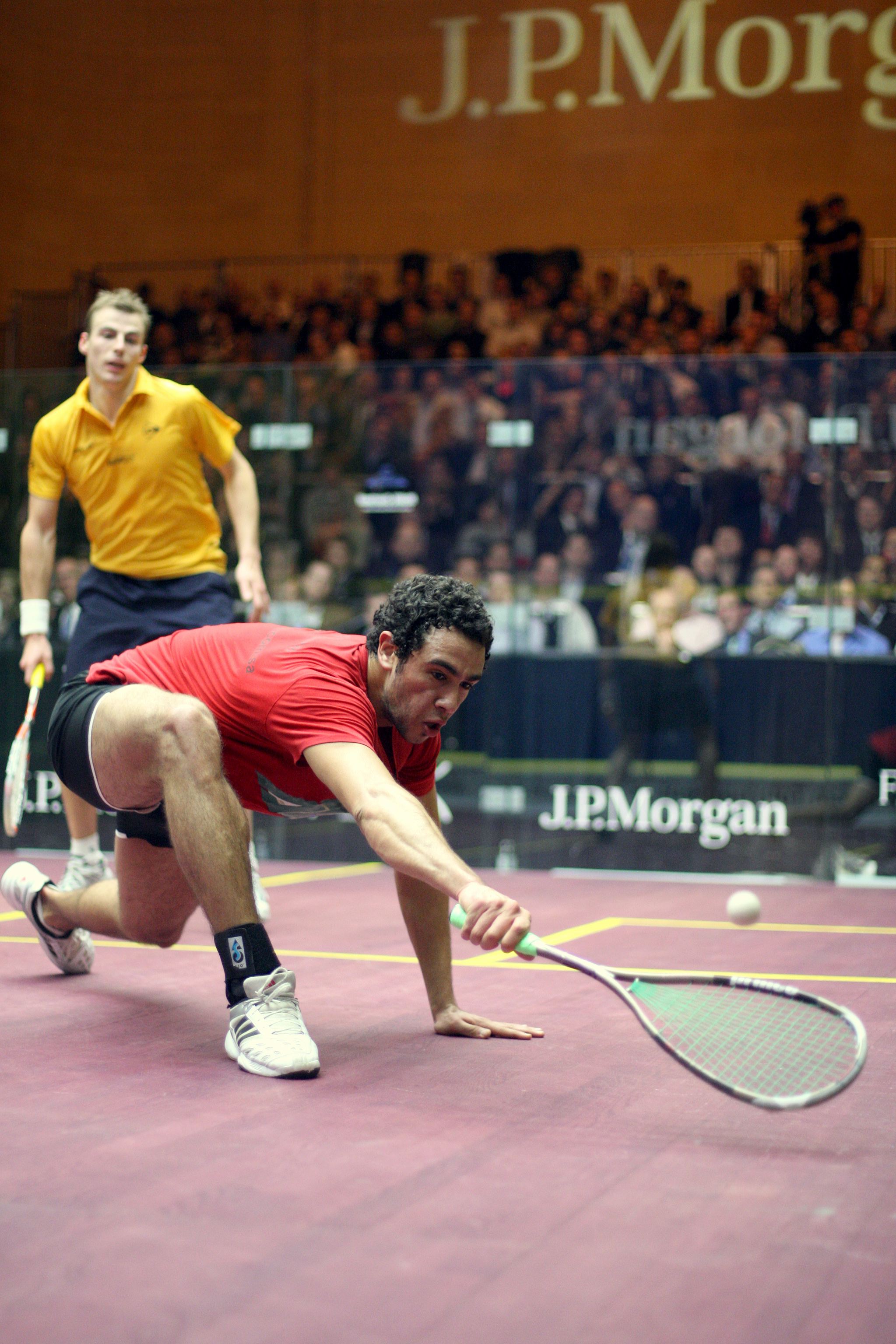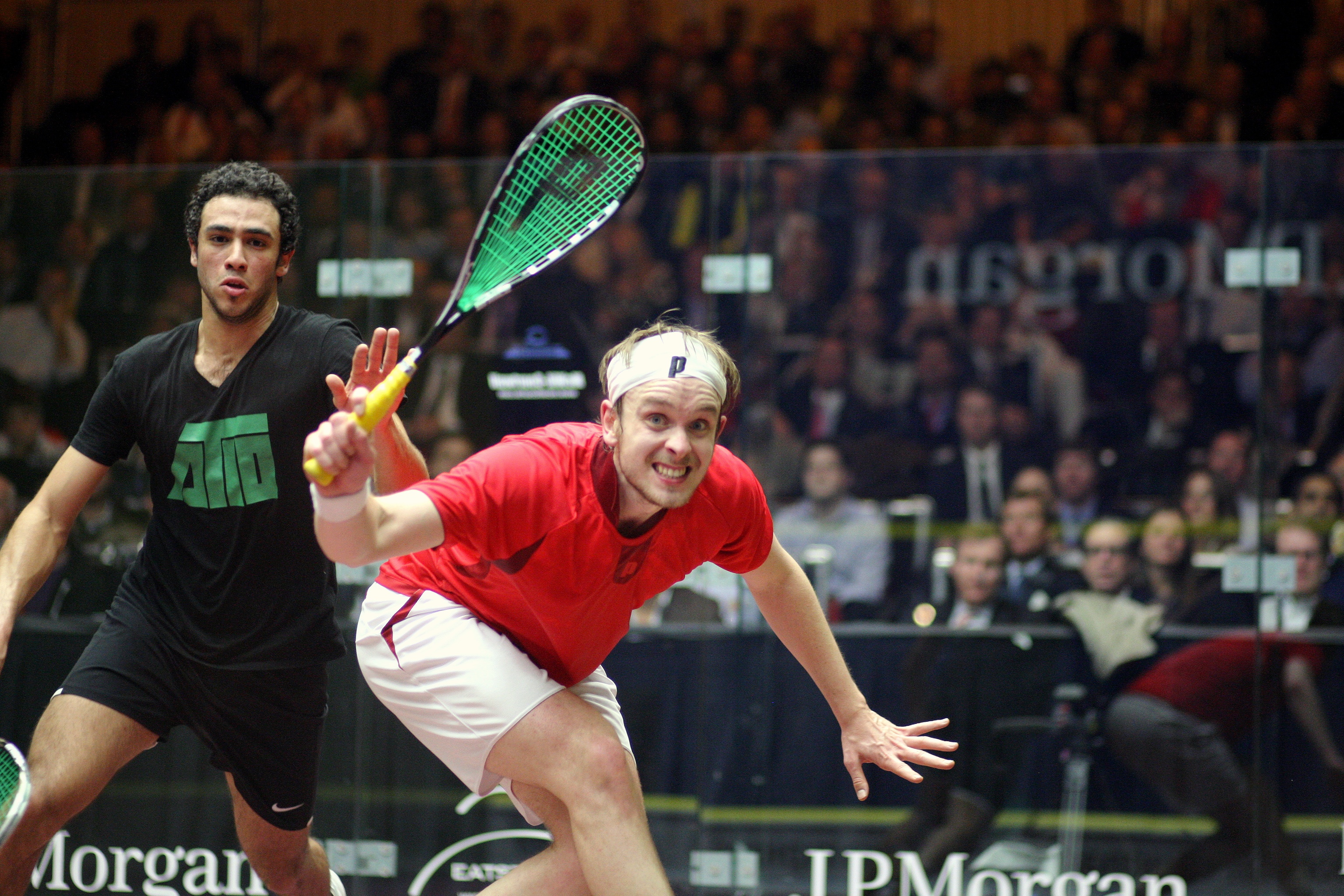
By James Zug
Photos by Steve Line/SquashPics.com
John Nimick has produced thirty-one glass court events. The Hall of Famer has survived economic meltdowns, untold numbers of meetings and the horrific asperity of September 11th. And still managed to put on first-class tournaments.
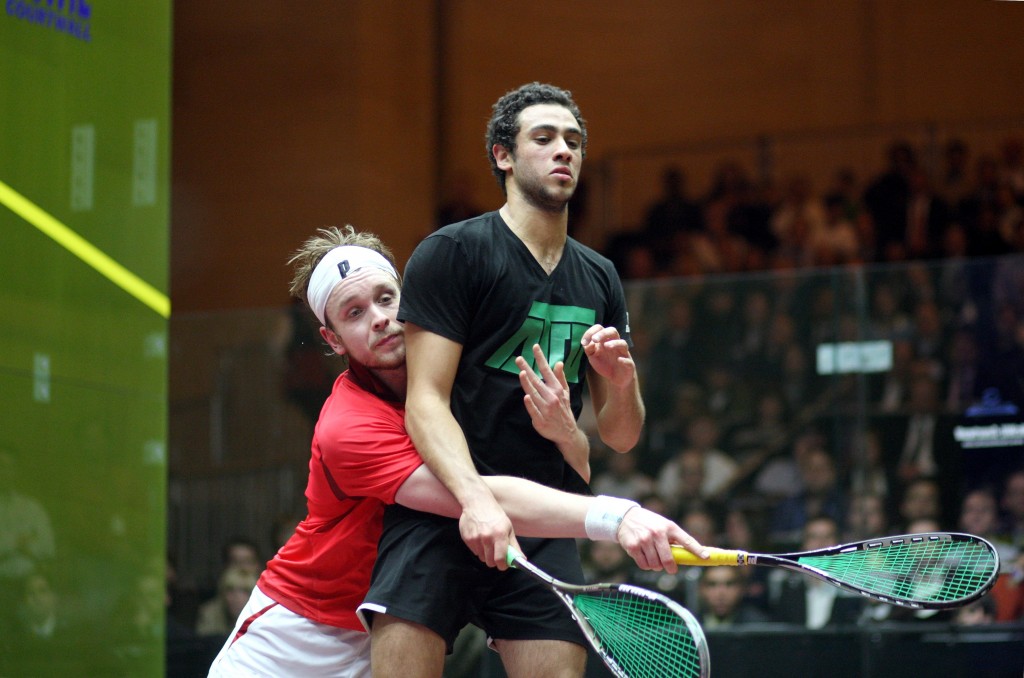
While we calculate, consider this: it was the thirteenth time that Nimick had brought the glittering, flag-bedecked, portable glass court to Grand Central, perhaps the trickiest location in the country. There was the one-off in June 1995 and then the current streak of twelve consecutive winters that started in January 1999.
Reflecting the brutal physical requirements of being a professional squash player, only three entrants in the 2010 J.P. Morgan Tournament of Champions slashed the ball at the 1999 edition (none, of course, remain from 1995). One was Stewart Boswell, the dour former World No. 4 who at 31 is still in his comeback from his two-year layoff due to a back injury. Bozza retired halfway through his second round match v. Nick Matthew with a knee injury.
Another was Amr Shabana, who was an unheralded 19-year-old when he first came to 42nd Street. Funny to think that it took until 2005 for the Prince of Cairo to get out of the second round at a ToC. Shabana, a two-time ToC winner, went out quietly to James Willstrop in just a half-hour quarterfinal affair, after a torturous overtime-in-the-fifth escape in the second round over a stroppy Alister Walker. Afterwards, Willstrop called Shabana the Ronnie O’Sullivan of squash. Or rather that O’Sullivan might be the Shabana of snooker.
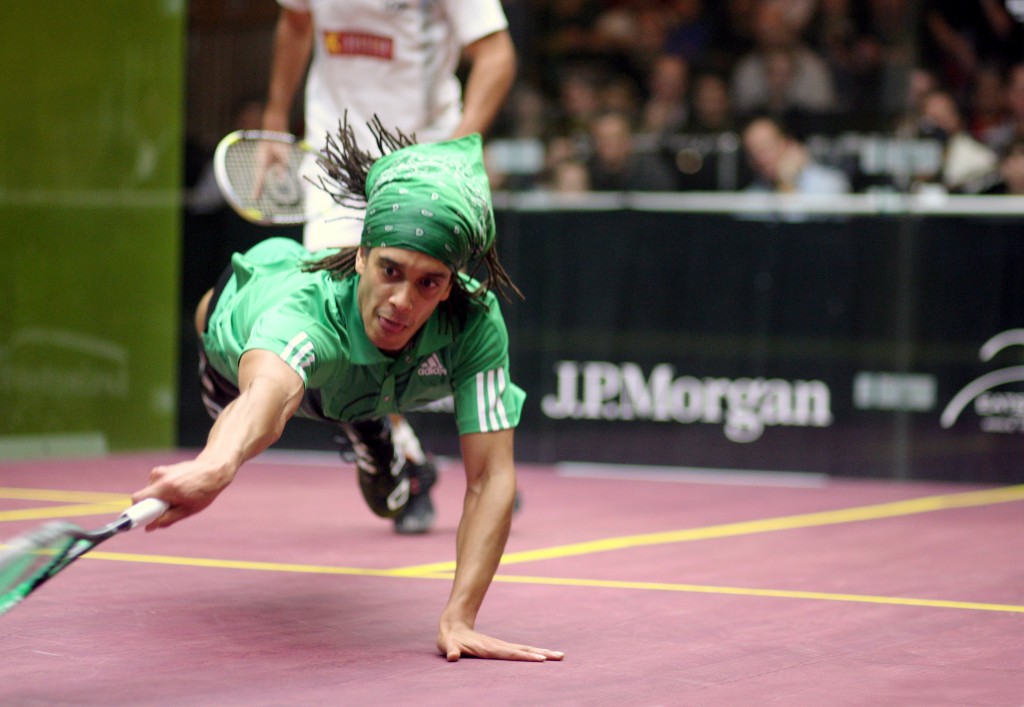
Only one man has been in all 12 draws: David Palmer. The 33-year-old Aussie has been in the world top-ten for 113 straight months, a stunning model of consistency. Palmer is now the grand old man of the game. He recently left his base at the University Club of Boston and moved to Orlando, where, following in the lucrative path of fellow PSA stars like Rod Martin, Paul Johnson and Chris Walker, he is now privately coaching a few juniors. His ToC record is very good, with him reaching three semis and three quarters (including this year), yet for a man who has four British Opens and two World Opens under his belt he has been surprisingly unsuccessful in New York—nary a final, let alone a win. Maybe a few months down at Disney World will sprinkle that final bit of stardust on the scowling hardman, and 13 will be a charm for him next year.
One of the highlights of the week, ironically, was the two-game exhibition between two of Palmer’s longtime colleagues. Peter Nicol (36 years old) and Jonathan Power (35) played 43 times before: 22 to 21 in favor of Nicol. Their best match was one of the greatest in the history of the ToC (and remember that the ToC is the oldest professional singles tournament in the world), the 2001 finals when Nicol outlasted Power 15-9, 15-12, 13-15, 13-15, 15-11 in 111 minutes. They also won every ToC between 1996 and 2004. For many, they embodied the ToC and it was especially poignant to see the two thoroughbreds out there again, Affirmed and Alaydar, galloping after each other’s shots. John Nimick is promising a Legends of Squash tour around the U.S. and U.K,, and while neither Power nor Nicol have maintained the fitness that Palmer has, they still possess that quickness and felicity of touch that made their rivalry so prodiously enthralling.

At the other end of the exhibition spectrum was what might have been called the Future Legends Faceoff (instead of the clunky “Elite Junior Women’s Exhibition”) which featured two teenagers who soon, it is eternally hoped, could perform in a bonafide glass court tournament in Grand Central—in nine of the 13 editions, there has been some sort of women’s exhibition or mini-tournament but never yet an equivalent WISPA 32-women tournament. Amanda Sobhy beat Olivia Blatchford in four. Their time, no doubt, will come.
American results otherwise were not particularly edifying, though it is interesting how quickly we have become used to the fact of having two in the main draw. Julian Illingworth was seeded No. 15, but lost in the first round. His wrist began bothering him before Christmas and a three-week layoff did not heal it completely. Gilly Lane had entered the qualies three times before, but this year, as the highest PSA-ranked American besides Illingworth, he earned Nimick’s wild card entry into the main draw. Since he was 15, Lane annually zipped up from Philadelphia every winter to the ToC, (the Penn varsity came en masse with him in college), and though he went down in three games to Karim Darwish, he thoroughly enjoyed being out on the stage after a decade in the audience. Three other Americans failed to qualify: Edward Marks and Karim Yehia lost in the first round of the qualies and Chris Gordon bounced Princeton’s David Letourneau out before losing in the second round to Nicholas Mueller in four.
Mueller was one of four main-draw players never to have been in the ToC before. Another was qualie Adrian Waller, who made the biggest splash of the main draw opening day. The 20-year-old Englishman was down 10-6 in the fifth game and survived the four match balls to sneak by Olli Tuominen.
Sentimentally, we all hoped that Chris Walker, age 42, might also climb into the main draw, but after a 70-minute first qualifying round upset of Matthew Karwalski, he sputtered and ran out of gas against Ryan Cuskelly, an Aussie who had not been born when Walker joined the PSA in 1987.
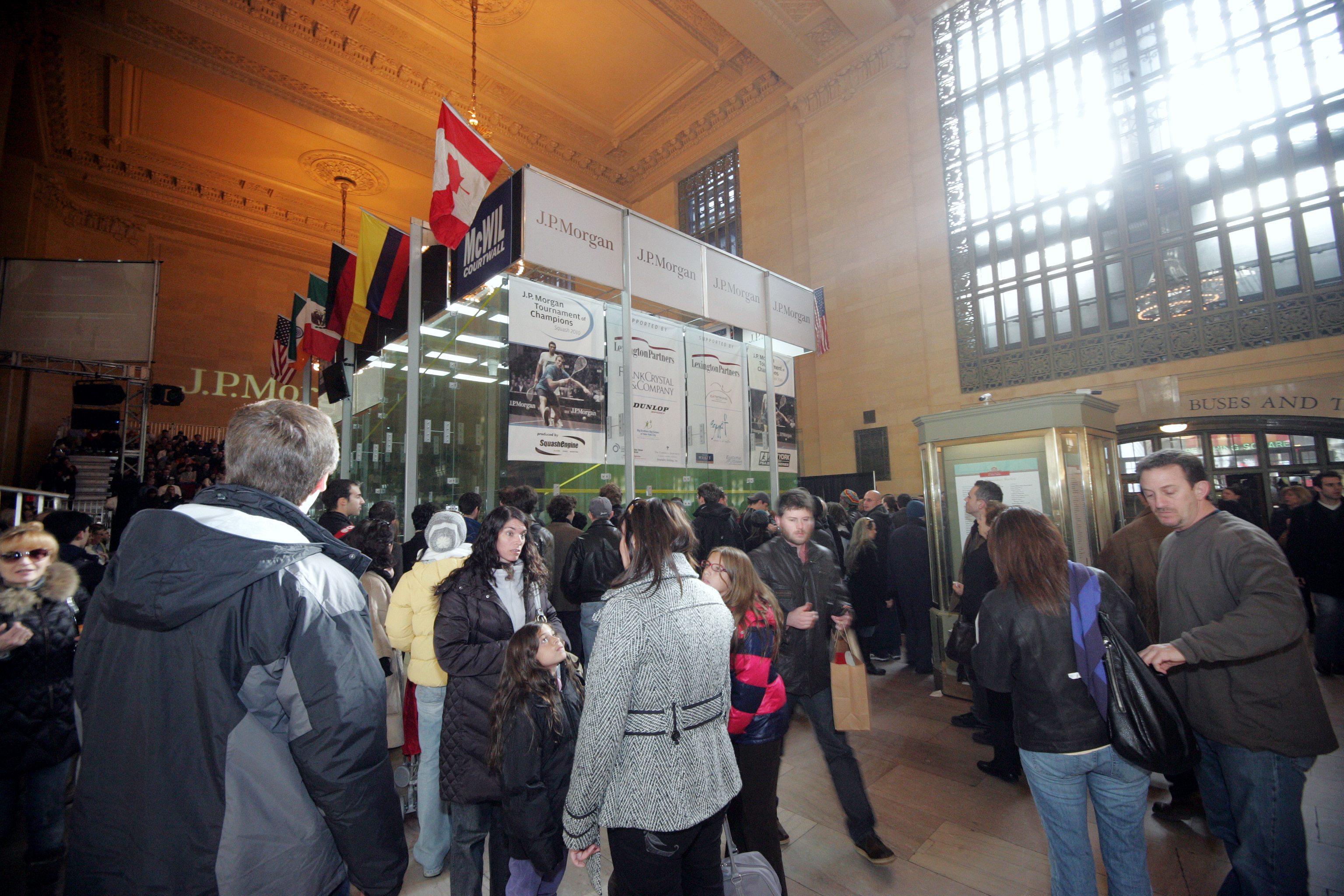
Even by ToC standards, this year’s draw was an especially global group. Players hailed from 19 nations (and make it 19 1/2, for Englishman Alister Walker was born in Botswana). And it was not all one-offs. Two Colombians, Bernardo Samper and Miguel Rodriguez, faced each other in the opening round, (how often do two guys from the same South American country play each other in a Super Series-level tournament?). Both had Trinity on their mind: Samper played there for four years and this winter Rodriguez has been training there in between tournaments.
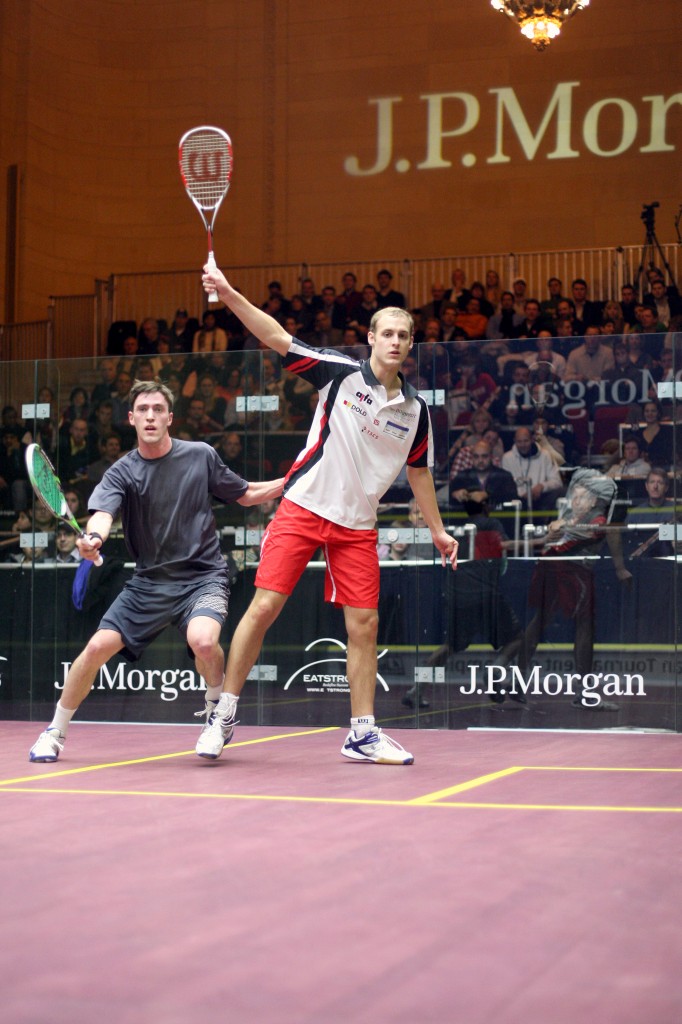
Hegemonic Egypt was the best of the 19 countries: 11 Egyptians came to New York and four of the eight quarterfinalists were from Cairo. It was fitting then that the Egypt Tourism Authority sponsored the tournament and gave away two free vacations. One Egyptian was Wael El Hindi. He first came to the States when he made the final of the 1998 World Juniors at Princeton, and last year the ebullient Egyptian moved permanently to New York when he took a job at CityView, the new facility in Long Island City. With his neck tattoo, diamond-studded front tooth, Bermuda shorts and Day-Glo shirts, El Hindi still exhibits a devil-may-care attitude. But he had lost 12 pounds this fall and with new hometown support he won two rounds and looked closer than ever to fulfilling his potential.
And then there is Ramy Ashour, the long-legged boy wonder, who was doing some magnificent things with the ball. He faced Nick Matthew, reprising their seminal match in Saudi Arabia the month before and putting on court the two men pictured on the cover of the program and on the giant poster hanging in Grand Central’s main hall. Ashour again won and did it with consummate style, one swan dive and not a few cross-court nicks.
The world has been waiting for a rivalry to emerge now that Power & Nicol are gone and if it is not Ashour & Matthew then perhaps Ashour & Willstrop. They had split the past four times they faced each other and their finals was scintillating stuff in part because Willstrop played the best squash of his life in Grand Central. The Yorkshireman won’t be 27 until August—he is now in the prime of his career—and looks poised to become the next man in the revolving-door of World No. 1. He frightened himself nearly to death when he turned his ankle at the start of his second-round match against Mohammed Reda. After surgery last April and a long recovery, he was loath to reinjure himself.
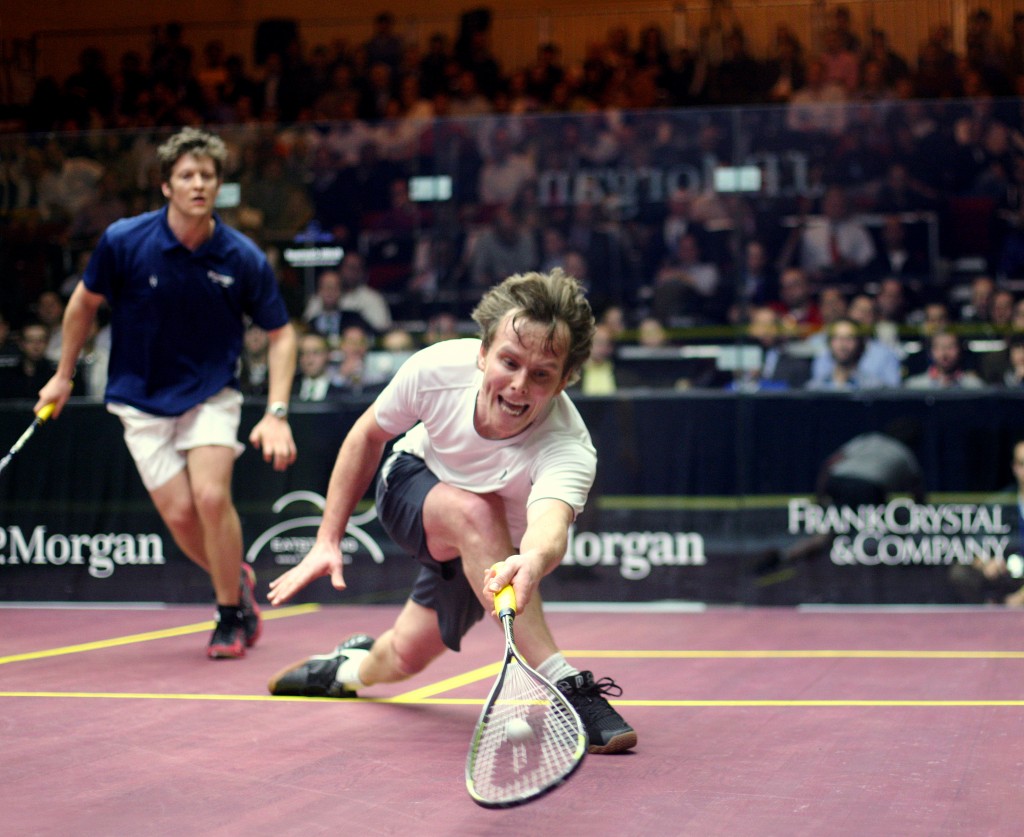
He didn’t and went on to have a great finish. Seeded sixth, he chopped up on three successive nights Shabana, Karim Darwish and Ashour, the Egyptian’s Murderer’s Row, with the loss of just one game. Quite a good go considering that Willstrop had not even made a final since his heartbreaking loss in the British Open final in September.
I sat with Malcolm Willstrop, James’ snaggletoothed, sage father, during James’ opening round match. Malcolm said that realistically there were six men who could win any Super Series tournament. But with his world ranking down at seven and the memories of twice having match balls in British Open finals and failing to convert, would Willstrop really be able to win? “Oh, yes,” said Malcolm. “You move on. You don’t dwell on the past. You can’t obsess about what has happened or what title you haven’t won.”
Good advice and his son is following it.
Spanning the Globe
“Get Your Squash On!” was the ToC motto this year and you could do this from the privacy of your own home. Yes, it was again great to be in Grand Central. Below the chandeliers, the new look of the J.P. Morgan VIP lounge was striking. Instead of the round tables and folding metal chairs of yesteryear, Morgan had brought in their own furniture from their corporate suite at the U.S. Open at Flushing Meadow. The square marble seats and glass tables and the abundant video screens (including the giant two-sided one near the court, gave everything a Scandanavian feel to Vanderbilt Hall. And there was another ping-pong afternoon on the court, raising thousands for the Big Brother Big Sister charity.
 But it was also cool, as I did, to be able to watch the matches in two different countries. Six years ago the ToC was the site of the first live Internet streaming of a pro tournament; this year it was where the PSA launched SquashTV. With a dozen black-clad Englishman on staff, the SquashTV production team offered on-demand Internet viewing. Yes, it took a laborious effort to register at the website and yes, there is none of the polyphonic noise of Vanderbilt Hall—the sliding of commuter’s feet, the click of Steve Line’s camera—but it was very cool, especially to hear first-rate commentary from Peter Nicol.
But it was also cool, as I did, to be able to watch the matches in two different countries. Six years ago the ToC was the site of the first live Internet streaming of a pro tournament; this year it was where the PSA launched SquashTV. With a dozen black-clad Englishman on staff, the SquashTV production team offered on-demand Internet viewing. Yes, it took a laborious effort to register at the website and yes, there is none of the polyphonic noise of Vanderbilt Hall—the sliding of commuter’s feet, the click of Steve Line’s camera—but it was very cool, especially to hear first-rate commentary from Peter Nicol.
More revolutionary was the fact that SquashTV lived up to its name. The finals were broadcast live in Malaysia on Astro, in Singapore on Starhub and on PCCW in Hong Kong. In addition, Nile TV was supposed to take it, but when Egypt made it into the finals of the African Cup of Nations soccer tournament, they ran it on tape-delay.
Globally live on television—that takes Get Your Squash On to a whole new level.


